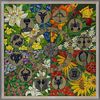Flower EncyclopediaENTER THE WORLD OF FLOWERS |
Other News
Petunia hybrida, Petunia superbissima
Category: Balcony flowers
10 Sep : 12:59
To view pictures click on them




 Petunia is an annual plant of the nightshade family (Solanaceae). Comes from the tropical parts of South America and mainly in Brazil, where and gets its name (from the Brazilian word for tobacco (petun) because of the amazing similarity between the two plants).
Petunia is an annual plant of the nightshade family (Solanaceae). Comes from the tropical parts of South America and mainly in Brazil, where and gets its name (from the Brazilian word for tobacco (petun) because of the amazing similarity between the two plants).Petunia has branched stems and flowers as a funnel. It flowers from May to late autumn. Grows well in sunny areas and requires regular watering. Propagated through February-March through semena.Petuniyata with its variety of colors, shapes, colors, heavy and prolonged bloom is among the most popular garden plants. Data from the U.S. specialists 30% of total seed production of flowers in the world are those of petuniite.
Diversity of different species, varieties allows successfully be used for curbs petunia, flower walks, hanging baskets and pots. Today petuniite flourish with all the colors of the rainbow, without the brilliant yellow, orange and black. Planting hybrid varieties are used by the first generation. The most notable qualities are its compactness, abundant flowering and resistance to diseases and external influences.
The genus takes its name from the word petun - Brazilian name for tobacco - a hint of similarity between the two genera. This species is the result of crosses is one of the most common in our country. The stem is branched and the height of the varieties ranged from 20 to 50 cm Colors are cone shaped, located singly on short stalks, leaving the breasts of the leaves.
The great diversity of this species may be limited to the following groups: Petunia hybrida nana compacta - a low, thick stems and smaller flowers; Petunia hybrida grandiflora - with larger flowers; Petunia hybrida pendula - petunia balcony with hanging stems. In each group there are varieties with colorful stripes or colors.
Petunia superbissima is curly petunia, which has wider leaves, thick stems and significantly larger flowers with a broad and open-necked frilly periphery. It provides significantly less colors from Petunia hybrida, which are very delicate and easily fall off in the rain or dew careless. With your other requirements do not differ.
Known are many varieties of Petunia:
- Petunia superbissima - with broad leaves and large flowers with curled periphery;
- Petunia hybrida pendula - with hanging stems;
- Petunia hybrida nana compacta - with thick stems and small flowers;
- Petunia hybrida grandiflora - large flowers.
Most often creating hybrid forms of varieties Petunia axillarisPetunia integrifolia (petunii violet).
In each of these groups can be seen both monochrome and colored variations. The colors are: white, pink, red, violet, blue, relatively recently been selected and yellow varieties.
Is widely used for flower beds and grass in parks and gardens, cultivated on balconies.
All petunii love heat and sun, grow well in open sunny places, do not like windy require temperatures above 5-10 °, not whims to the soil, but must be watered every day, and if grown in containers need to be nourished regularly with a combined fertilizer for flowers 2 times a month. If the plant for no apparent reason begin fades and leaves gleamed yellow, most likely the roots have begun to rot because prepolivane. We try to save him if he replanted in new soil. Pests that are most often attacked petuniite are Slug.
For the foundress of modern hybrid corn is considered petunia Petunia axillaris and Petunia violacea. Their origin is from the tropical regions of South America. Today there exist 35 species of these plants. Petunia belongs to the nightshade family (Solanaceae), the species and subspecies Cestreae Nicotianinae, quite close to tobacco (Nicotiana), from which it differs only in single colors. A reminder that this family are well known to us tomatoes, potatoes, eggplant, tobacco, datura and grown in gardens "Angel trumpet and many others.
These plants are upright or Widespread stems, their leaves are bristly with hairs, 5-10 cm long Petunia is a unique botanical genus, which differs from all others with wealth of colors, good adaptability to growing conditions and various decorative features.
It is customary to believe that the name of petunia proihozhda from "petun", known in Brazil as well as tobacco. According to other sources, however, the name of the flower is associated with the fact that the first garden petunii were discovered in 1850 in private gardens, in the course of their cultivation of the French botanist Petunia.
In 1881 Theodosia Shepherd (1845-1906) of California sends packets of seed of the then famous seedsman Peter Henderson. These were grown from seeds from her earliest type of hybrid petunii Superbissima, later called "a giant petunii from California. Begun to deal with flowers - first to help his family financially, later Theodosia Shepherd is a professional manufacturer of roses, bulbs and seeds.
Today, this kind of large-flowered petunii is not among the favorites because it is quite sensitive to wind and rain, gives less color than the newer varieties, and even if grown in isolation, degenerate, and the colors it izdrebnyavat.
Further cultivation and development of petunia leading to two of the most cultivated hybrid types of first-generation - Hybrid grandiflora - Large color and Hybrid multiflora - with multiple colors. Each of these has two early varieties petunii - single and decoration colors. Among other things these two can meet with different colors - brightly colored two-color and monochrome - with prozhilki, with a bright star or central part, and also with smooth edges, with smooth or wavy edges, with curly petals.
Petunia grandiflora type was created in 1950 and the first hybrid petunia - F1 hybrid grandiflora "Ballerina" was presented in 1952
Traditionally, those seeking petunii much, because they are spectacular and attract attention. They have large flowers to 11 cm - two-color, curly, decoration or saturated monochrome colors.
Petunia multiflora type was created in 1940, the first hybrid petunia - F1 hybrid multiflora is "Comanche", presented in 1953. Petuniite of this type have smaller flowers 3-5 cm in size, but they are more in number, are more resilient than grandiflora, form a more compact plant and received a larger spread due to their various colors . More popular varieties of this type are: Carpet, Celebrity, Horizon, Merlin, Polo, Primetime.
By crossing the two types of hybrids - grandiflora and multiflora occurs Petunia florubunda, but type it is so consistent quality.
And has created a miniature petunia type milliflora. Because it is a compact plant can be used in places where other hybrid petunii are not appropriate. For example, it is ideal for hanging small containers, mixed color combinations, containers with unusual shapes and generally in places where traditional petunia looks too bright and lively.
In 60-70-years of the last century Petunia attracted the attention of biologists as a convenient site for developments associated with somatic hybridization of species. These studies attracted the attention of breeders. The result appeared wonderful new hybrids of Petunia.
The first of these sales received naimenovenie "Surfinia". On its appearance, they resemble ampelni petunii, but are distinguished by dark or bright spots of color in the center. Ampelnite petunii blooming flower with multiple funnels and are flexible, pendulous stems. Surfiniyata unlike ampelnata petunia can not be propagated by seed. Even when we are able to collect seed from it, they do not repeat their qualities in the offspring, so multiply vegetatively.
In the 90 years comes a new boom in the selection of petuniite. Then specialists from the Japanese company Suntory Ltd. found in South America forms of petunia, which led to the creation of new varieties of ampelni trademark "Surfinia". In 1989 they welcomed equally well in Japan and Europe. Total over 120 million units of this series petunii fans delighted gardeners from 24 countries. These new cascade petunii are characterized by strong growth, long stems and hanging unusually heavy, sumptuous colors. Large (up to 6 cm in diameter) surfiniyata colors are dyed in various colors, but most often it is saturated with dark tones or bright central part. Suntory is the development and mini-Petunia "Million Bells" (calibrachoa). Unfortunately, these magnificent plants are vegetatively propagated and are only for lovers nedostani in sufficient quantities because of expensive imported seed.
Similar developments in the selection of cascade petunia and other companies do. Israeli "Danziger" (Israel) offers petunii Branded "Cascadias", "Petitunia", "Doupetini" and "Doublon" (thick as carnations) and mini-petuniite (calibrachoa) it bear the mark "Calimor". Australian company Florigen, known for his development of blue roses, petunia developed "Supertunia".
Petuniiite Supertunia series in gorgeous colors, colors are incredibly durable, not need much care. Some fans of diversity will likely be disappointed by the fact that supertuniite occur only in shades of white, pink and purple, but these petunii can surprise us with its rapid growth - almost 3 cm per day and the ability to quickly fill the huge hanging basket. Of course, to enjoy its heavy blooms will have to nurture it more often than other species. In these greenhouses petunii receive nutrients with every watering.
Most often seedlings petunii choose according to your preferences for color, but petuniite of this series can be very different in shape and size. Some form a compact bush, others are great for containers and hanging sandacheta, some are beautiful with their colors, like gillyflower. But do not look for seeds of these petunii - surfiniite and they only reproduce vegetatively. You can try to multiply them by twisting through sprig away and try to root it in a glass jar.
At the same time, several companies conducted a selection of hybrid varieties petunii multiplied by seed. The first one is petunia "Purple Wave", the Japanese company "Kirin Brewery Co.Ltd." In 1995. it became a winner in the rankings of American organization AAS (All America Selection) testing and testing of new varieties.
Interestingly, the main activity of "Kirin Brewery Co.Ltd." is the production of beer.
The various varieties of hybrid petunii be divided into several groups:
- Multicolored petunii have a huge amount of flowers to 5 cm in diameter. Unpretentious, well grow in any sunny garden locations soil;
- Petunii multicolored decoration - decoration have multiple colors that resemble the color of a carnation with a diameter of 5 cm in diameter;
- Large-flowered petunii - not so profuse blooming in warm temperatures are the requirements to have more growing conditions. The diameter of their color is from 7 to 10 cm;
- Large-flowered petunii decoration - are very impressive, look like roses;
- Curly petunii (fimbriata) - have large flowers with curly edges;
- Super-large-flowered petunii (superbissiuma) have very large flowers to 12 cm in diameter) with curly edges and numerous tamnootsveteni stripped.
Mix of modern hybrids petunii is huge - over 500 samples. All of them are characterized by an early and profuse flowering, compactness and resistance to adverse growing conditions. The most popular varieties are: "Abendsonne", " 'Admiral", "Alphons", "Brilliantrosa", "Weisse Wolke", "Wurtemberger", "Kakadu", "Rheingold" and many others
Flowering period: May to September.
Origin: Starting forms - South America.
Mestorastene: Sunny.
Substrate: Optimal finger finger for balcony flowers.
Planting: Buy ready-made or grown alone (- ¬їGeneration) young plants are planted at a distance of 20-25 centimeters from each other.
Irrigation, fertilization: is abundantly watered and fertilized less each week.
Other care: Pretsaftelite detachable flowers every day. Formation of seeds is very fast. After the first flowering (late July / early August) when the plants are placed in long shoots and begin to fall, be cut in half. Petuniite be reimbursed for 14 days buhlati grow and bloom again magnificently.
Hibernation: Not required.
Pests, Diseases: Mostly aphids.
Propagation: Petunia reproduced by seed. Sown in January to zatsaftyat in the second half of May. Soil is a mixture of compost, greenhouse soil and sand or perlite, and it is slightly pritapkva after sowing. Sandachetata kept at 15-20 ¬∞ C. Once the form of leaflets 2 pedicle sprouting, transplant to a distance of 3.4 cm or one in saksiyka вДЦ 6-8.
In type Petunia hybrida seeds are very tiny and sown, may also be mixed with a little sand for a more even distribution in the chest.
To obtain viable seeds of Petunia superbissima required artificial pollination.
Neugnil use of manure or nitrogen fertilizer reduces flowering!
Petuniite combine well with a small balcony flower colors, such as Margarita, Felicia, lobelia, blue coin.
Petuniite belong to the poisonous nightshade plants!
| family solanaceae stems and flowers nightshade family colors of the rainbow late autumn |
Comments are turned off for this item0
| family solanaceae stems and flowers nightshade family colors of the rainbow late autumn |























































